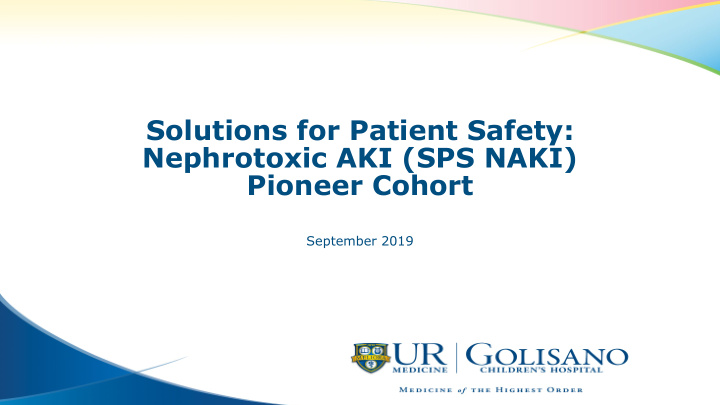



Solutions for Patient Safety: Nephrotoxic AKI (SPS NAKI) Pioneer Cohort September 2019
SPS: NAKI Pioneer Cohort Vision Statement: Children should only get the nephrotoxic medications they need for the duration they need them Aims: Global aim: eliminate all nephrotoxic medication-associated acute kidney injury (NAKI) in hospitalized children Smart Aim : Decrease the NAKI rate by 30% in non-ICU population by December 31, 2019 Smart aim : Measure NAKI in ICU settings
Nephrotoxic Medication Associated AKI (NAKI) Nephrotoxic medication exposures (NTMx) • Over 80% of patients have > 1 NTMx • > 3 NTMx in 1 day associated with ↑ risk for AKI NAKI • Common cause of AKI in non-critically ill hospitalized children • ~ 25% of inpatients • Underestimated due to lack of systematic surveillance of kidney function in exposed pts non-oliguric nature of NAKI 3
Clinical significance of NAKI Increased LOS, cost, risk of CKD 70% of children with NAKI had evidence of residual renal damage 6 mo later ↓ eGFR 6 mo post NAKI NTMx w/ AKI NTMx w/o AKI p Hyperfiltration eGFR (Cr) (ml/min/1.73 m 2 ) 113.8 (n =77) 123.4 (n =57) 0.04 Proteinuria < 60 (CKD Stage <3) 2 0 Hypertension 60-90 (CKD Stage 2) 16 0 90-150 (CKD Stage 1) 50 56 >150 (Hyperfiltration) 9 1 eGFR (Cys-C) (ml/min/1.73 m 2 ) 80.2 111.4 <0.01 U prot/cr 0.9 0.27 0.04 HTN 38% 19% 0.01 Early detection is key Minimize nephrotoxins 4 Provide supportive care
NAKI Definitions AKI definition (for this cohort) ↑ in creatinine at least 50% above baseline Baseline creatinine = lowest creatinine in the past 6 months Creatinine must reach 0.5 mg/dL to be called AKI OR An absolute ↑ in baseline serum creatinine ≥ 0.3 mg/ dL over 48 hours regardless of max Cr NAKI definition – AKI that occurs w/in 2 days of nephrotoxic med exposure Exposure > 3 nephrotoxic medication exposures (NTMx) on 1 day OR > 3 consecutive days of vancomycin or aminoglycoside NB - IV contrast, Amphotericin B, cidofovir count for 6 days post administration 5
Nephrotoxic Medication List 46 Drug Drug Medications Medications which can trigger Medications Medications which can trigger Therapeutic Therapeutic which count as an without another medication which count as an without another medication monitoring moitoring exposure for 7 d on day 3 of exposure exposure for 7 on day 3 of exposure recommend recommend days ed ed X Acyclovir Ioxilan Ambisome Ketorolac X X Amikacin Lisinopril Amphotericin B X X Lithium Aspirin Losartan Captopril Mesalamine Carboplatin X Methotrexate Celecoxib Mitomycin Cidofovir X Nafcillin Cisplatin Naproxen Colistimethate Pamidronate disodium Cyclosporine X Pentamidine Deferasirox Piperacillin Diatrizoate meglumine X Piperacillin/Tazobactam Diatrzoate sodium X Polymixin B Enalapril X Sirolimus Enalaprilat Sulfasalazine Foscarnet X Tacrolimus Ganciclovir Tenofovir Gentamicin X X Ticarcillin/Clavulanic Ibuprofen Acid X X Tobramycin Iphosphamide Topiramate Indomethacin Valacyclovir Iodixanol (Vispaque) X Valganciclovir Iohexol (Omnipaque) X Valsartan Iopamidol (Isovue) X X X Vancomycin 6 Iopromide X Zoledronic acid Ioversol X Zonisamide Ioxaglate meglumine X and ioxaglate sodium
Weekly average AKI intensity rates measured as days in AKI by the pRIFLE per 100 days of high nephrotoxic medication (NTMx) exposure. 8 Stuart L. Goldstein et al. Pediatrics 2013;132:e756-e767
NAKI preliminary data – GCHaS (non-ICU pts) Dec Jan Feb Mar Apr May SPS 2018 2019 2019 2019 2019 2019 data range #NTMx exposures 26 23 33 20 20 35 21 22 29 19 19 32 #NTMx w/ baseline sCr (%) (81) (96) (88) (95) (95) (91) #NTMx w/ daily sCr (%) 6 (23) 8 (35) 7 (21) 5 (25) 6 (30) 4 (11) #NAKI episodes 3 2 2 1 1 ? % NTMx resulting in AKI 11.5 8.7 6 5 5 8 - 13% 9
The Process Pharmacists Provide SCr Data Analyst Share with AKI create/receive …and generate screening compiles registry team, leadership, daily reports, metrics, run suggestions if from Pharmacist other verify & charts necessary reports… stakeholders validate
NAKI implementation at GCHaS Inclusion All non-ICU inpatients 7N/S, 8N/S Exclusions: ESRD (SPS exclusion) Pt in Wilmot Cancer Center and pts off tower (GCH exclusion) PICU and PCCC pts Monitor NICU pts for exposure but 11
NTM Exposure Algorithm Pt meets exposure criteria Open encounter Check daily Cr during period of exposure and up to 48 hrs after last exposure Pt meets AKI criteria Monitor daily Cr until back to baseline for 48 hrs and no further exposure If still exposed continue daily Cr until 48 hr after last exposure 12
NAKI Implementation at GCHaS Peds pharmacy to contact provider if pt meets exposure criteria Opportunity for education; Pharmacist will recommend creatinine monitoring & can place order if provider agrees Per NAKI surveillance, pt should have daily Scr monitored until 48 hrs after exposure stops, OR 48 hrs after AKI resolves, OR Up to 28 days following AKI episode which does not resolve Nephrologist to contact provider if sCr not ordered to explore barriers to daily sCr monitoring 13
Nephrotoxic Medications 14
Education and resources NAKI team Pharmacy Peds Nephrology website Peds ID website Link to the list of nephrotoxic medications 15
GCHaS NAKI Team IT E. Kanouse Pharmacy T. McCollum, M. Santana, S. Stauber Information Analyst D. Prinzing Residency M. McLaughlin QI J. Schriefer Nursing K. Brown Nephrology P . Brophy, M. Lande, A. Mian, E. Rademacher, M. Rashid, G. Schwartz, W. Varade Leadership P. Brophy, T. Stevens NICU R. Guillet Infectious Disease M. Caserta 16
17
Recommend
More recommend